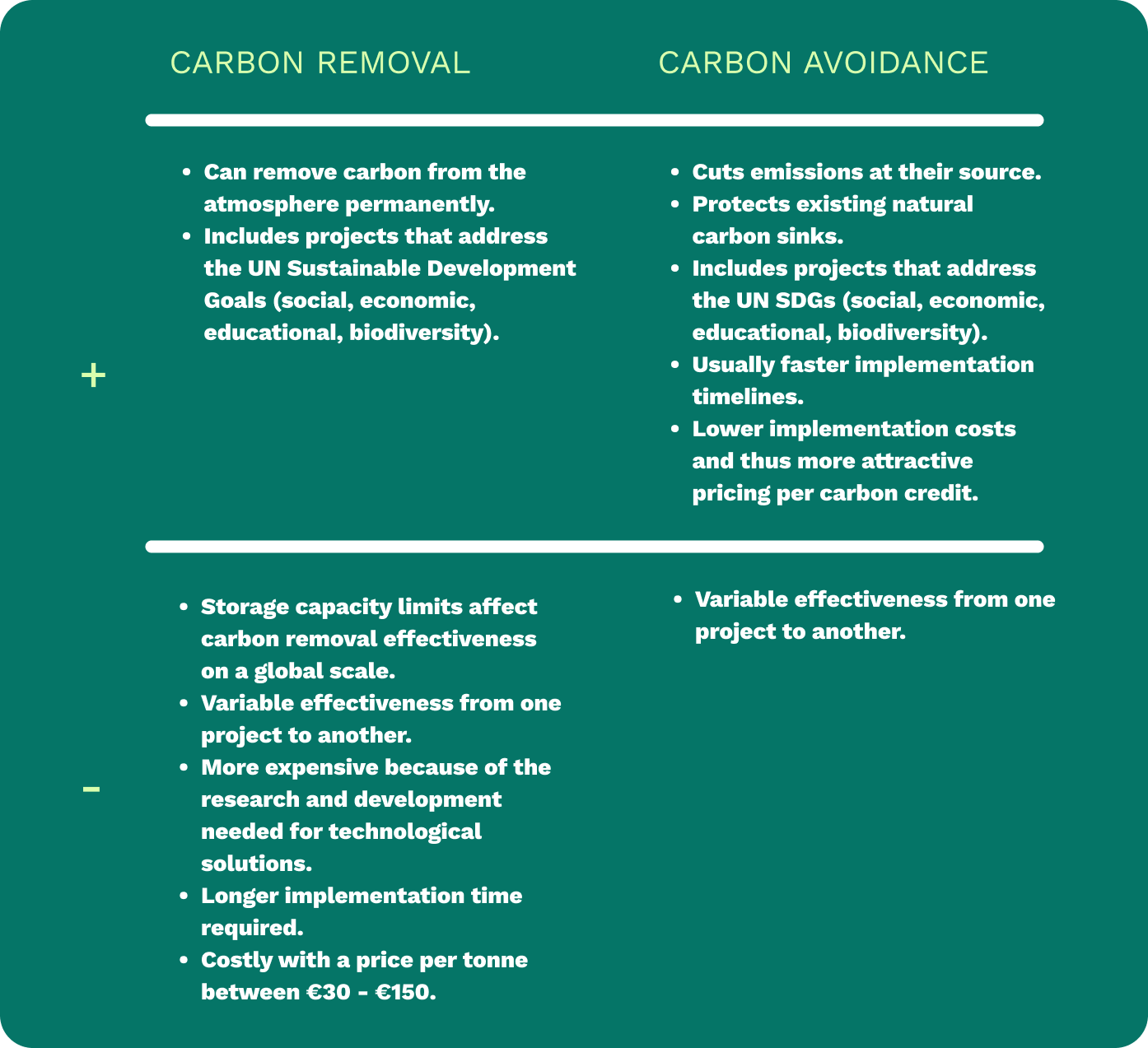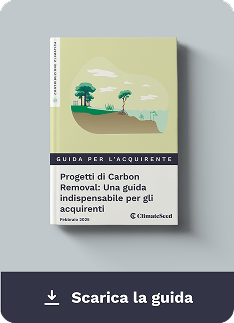La differenza tra progetti carbon removal e carbon avoidance
I progetti di riduzione del carbonio possono essere suddivisi in due principali categorie: progetti di carbon removal e carbon avoidance. Entrambi possono generare crediti di carbonio (se certificati) e sono ugualmente importanti nella lotta al cambiamento climatico.
Questo articolo vi consentirà di comprendere meglio la differenza tra i due e le loro specificità. Non esitare a contattarci per maggiori informazioni.

I progetti di carbon removal
I progetti che hanno come scopo di rimuovere la CO2 dall'atmosfera (carbon removal) possono riferirsi a due differenti attività:
-
La rimozione del carbonio attraverso la tecnologia: esistono alcune tecnologie specializzate che estraggono il carbonio dall'atmosfera. Ad esempio la cattura diretta dell'aria, un processo attraverso il quale il carbonio viene rimosso dall'atmosfera attraverso processi chimici. Per una maggiore efficacia, il carbonio deve essere intercettato direttamente dove viene rilasciato, spesso nelle vicinanze di siti industriali.
Potreste anche aver sentito parlare di Carbon Capture Utilization and Storage (CCUS), che si riferisce al processo di cattura di CO2 e al suo stoccaggio permanente o alla sua conversione in prodotti di valore (come il metanolo). -
La rimozione naturale del carbonio: si riferisce all'aumento della capacità di una foresta di assorbire il carbonio dall'atmosfera attraverso la fotosintesi, preservando i serbatoi di carbonio esistenti e creandone di nuovi. Alcuni esempi sono i progetti di riforestazione e afforestazione (che molto spesso includono anche iniziative nel settore agricolo). Inoltre, anche le mangrovie possiedono un'elevata capacità di assorbimento del carbonio.
I progetti di carbon avoidance
Esistono cinque principali tipologie di progetti che rientrano nella categoria dei progetti di carbon avoidance:
- Gestione forestale e uso del suolo: Questi progetti includono attività come gestione forestale, produzione di legname, pratiche di agroforestazione e ottimizzazione dell'uso del suolo.
- Energie rinnovabili: Contribuiscono alla decarbonizzazione della rete elettrica locale attraverso infrastrutture per l'energia rinnovabile, evitando così il rilascio di gas serra nell'atmosfera.
- Efficienza energetica: Utilizzo di una fonte di energia a minore intensità di carbonio, con conseguente riduzione delle emissioni di carbonio.
- Dispositivi domestici: Utilizzo di fornelli da cucina più efficienti, che richiedono meno legna per la cottura quotidiana, contribuendo così a ridurre la deforestazione. Questi progetti possono avere ulteriori benefici, tra cui il miglioramento della parità di genere, vantaggi per la salute, la generazione di reddito, la diffusione di conoscenze e la conservazione dell’ambiente.
- Gestione dei rifiuti: Anziché considerare i rifiuti come la fase finale del processo produttivo, questi progetti utilizzano attivamente i rifiuti per generare energia, minimizzare l'inquinamento e mitigare le emissioni di carbonio.
È meglio supportare progetti di carbon removal o di carbon avoidance?
L'uno non dovrebbe essere promosso a discapito dell'altro. Sono entrambi essenziali per raggiungere un futuro a zero emissioni nette. Tuttavia, è vero che sostenere solo i progetti di carbon removal non risolve il problema iniziale delle emissioni di gas serra rilasciate nell'atmosfera.
Dobbiamo ridurre le nostre emissioni e trovare modi innovativi per limitare i danni già fatti. Inoltre, è necessario proteggere i serbatoi di carbonio esistenti e crearne di nuovi.

Per maggiori informazioni sui metodi Carbon Removal, scaricate la nostra guida.
I progetti premium di carbon removal e di carbon avoidance di ClimateSeed
Da ClimateSeed, offriamo sia progetti di carbon removal che di carbon avoidance all'interno del nostro portafoglio di progetti. Abbiamo esperti dedicati che assicurano che i progetti siano della massima qualità e che abbiano superato il nostro solido processo di verifica a tre livelli. Il nostro approccio, unico nel mercato, massimizza gli impatti ambientali e sociali positivi e offre una mitigazione del rischio sostenuta da un'esperienza finanziaria di alto livello.
Esempio di progetto: Agroforesteria in Punjab
Il Punjab è una regione in India ad alta intensità agricola, con un sistema tradizionale di coltivazione del riso e del grano che ha contribuito alla sicurezza alimentare del paese. Tuttavia, la produttività di questo sistema è diminuita in alcune aree a causa dell'esaurimento delle riserve di nutrienti, dell'abbassamento delle falde acquifere sotterranee e della ricomparsa di insetti e malattie. Il progetto promuove l'agroforesteria sostenibile e affronta la crescente domanda di legname e prodotti arborei, fornendo questi materiali e, allo stesso tempo, conservando e riabilitando interi ecosistemi. Grazie a questo progetto, 24,8 milioni di tCO2e saranno sequestrate durante i 40 anni del progetto.
 Agroforesteria in Punjab
Agroforesteria in Punjab
Il progetto contribuisce a entrambe le priorità nazionali che sono state dichiarate per uno sviluppo sostenibile:
- L'aumento della resa delle colture, con conseguente aumento della produzione agricola e dei redditi.
- Miglioramento della gestione dei terreni agricoli grazie all'adozione di buone pratiche, aumentando così la capacità di adattamento del sistema agricolo agli impatti del cambiamento climatico.
Questi progetti rientrano nella categoria "Afforestazione, Riforestazione, e Rivegetazione" (ARR) del Verified Carbon Standard (VCS).
Per maggiori informazioni su questo progetto, leggi il nostro caso studio.
Contattaci per saperne di più.
Domande frequenti
ClimateSeed impiega un processo di selezione dei progetti approfondito e articolato in più fasi, per garantire che vengano scelte solo le iniziative di maggiore qualità e con un impatto ambientale e sociale positivo. Il processo di selezione inizia con l'ottenimento, da parte di ciascun progetto, della certificazione di standard internazionali o nazionali riconosciuti. Successivamente, il team di esperti di ClimateSeed valuta i progetti in base a una serie di criteri, tra cui tipologie, metodologie e aree geografiche. Viene inoltre condotto un controllo bancario preliminare per tutti gli sponsor dei progetti. Infine, i progetti sono sottoposti a una valutazione utilizzando un quadro di valutazione specializzato sviluppato dagli esperti di ClimateSeed. Per maggiori informazioni, contattateci.
Le mangrovie svolgono un ruolo cruciale nel sequestro naturale del carbonio, assorbendo e immagazzinando grandi quantità di CO₂ dall'atmosfera. Grazie al loro fitto apparato di radici e alla capacità di accumulare materia organica nei terreni intrisi d'acqua, catturano il carbonio in modo efficiente e sostenibile. I terreni delle mangrovie possono immagazzinare fino a quattro volte più carbonio per ettaro rispetto alle foreste terrestri, rendendoli ecosistemi essenziali per mitigare i cambiamenti climatici. Per maggiori informazioni su questo argomento, leggete il nostro articolo.
Potrebbe interessarti anche
Articoli correlati

6 motivi per misurare l'impronta di carbonio aziendale

La corsa verso la neutralità carbonica


